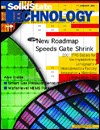Table of Contents
Solid State Technology
Year 2002
Issue 1
 | DEPARTMENTS
Editorial
Time for
For years the industry has talked about putting metrology instruments into process tools, or at least hooking them up in-line, so that wafers could be monitored either during processing or right afterwards.
World News
World News
Numbers rose across the board as the industry headed toward the end of 2001, with equipment orders, chip sales, and front-end capacity utilization all up for the month of October.
Tech News
Technology News
Curing blindness, limitations of CMOS are topics at MNC; Diagonals: A shorter path for interconnect ...
Asiafocus
Update from China: Taiwan talent builds entrepreneurial foundries
Who would have thought it only a few months ago? China seems to be growing an entrepreneurial semiconductor foundry industry thanks to the success of an aggressive drive to recruit industry talent from Taiwan.
Market Watch
MEMS: A fast growing niche
The market potential for microelectromechanical systems (MEMS), like everything else in high tech, has been in flux. Yet, a recent forecast (Table 1) indicates opportunities still exist across a broad segment of applications.
Product News
Product News
ICPECVD for low-temperature SiNx films; High-resolution optical microscope; Plug-and-play pumping system; Process monitoring for CVD and etch ...
|
|
FEATURES
Cover Article
Implant and process challenges on the ITRS front-end process roadmap
Solid State Technology has been working with the leaders of various technical working groups of the 2001 International Technology Roadmap for Semiconductors (ITRS) to outline highlights and crucial changes in the new ITRS for a broad range of fab operations, beginning here with front-end processing and continuing through wafer-level test.
Lithography
The end of optical on the ITRS lithography roadmap
The smaller features and tighter tolerances in the 2001 ITRS deliver the message that the industry is clearly approaching the physical limits of optical lithography (Table 1).
Industry Insights
A high-level view: The 2001 ITRS from altitude
The 2001 International Technology Roadmap for Semiconductors (ITRS) reflects two overall messages: the entrenchment of international consensus building and yet tighter periods between industry technology nodes.
Interconnects
The challenges in the ITRS interconnect roadmap
The 2001 ITRS continues to reflect the hierarchical wiring design trend featuring reduced aspect ratios (as an alternative means of reducing capacitance) and less aggressive scaling of the dielectric (see the table).
Factory Integration
Key challenges and directions in the 2001 factory integration roadmap
Successfully realizing the potential of ITRS targets requires an integrated factory that takes full advantage of its technologies to achieve device feature size reductions, near 100% yield, wafer-size increases, and other manufacturing productivity improvements (see table).
Metrology
The crosscut challenges of the 2001 ITRS metrology roadmap
Metrology continues to be challenged by the accelerated introduction of new technology generations as well as new materials and structures (see the table). In addition, new measurement requirements...
Wafer Level Test
Wafer-level challenges within the ITRS test roadmap
Wafer probe technologies face complex electrical and mechanical challenges driven by product specifications, test implementation requirements, test productivity goals, and reduced test cost demands (see table).
Packaging Assembly
An innovative approach to wafer-level MEMS packaging
A new wafer-level chip-scale package provides an integrated cavity above the active area of a MEMS device. This package was designed for devices with mechanically moving components such as micromirrors, miniature gyroscopes, and acceleration detectors.
Vacuum Technology
Recent advances in compact, smart vacuum, and gas pressure sensors
Miniaturization of sensors and electronics has led to several recent advances in high-vacuum gauges, including extended ranges and smart capabilities, as well as smaller size. For example, the range of Pirani gauges has been extended down to 10-5 torr, response time has been reduced, and electronics are integrated on the same chip as the sensor.
| |
|